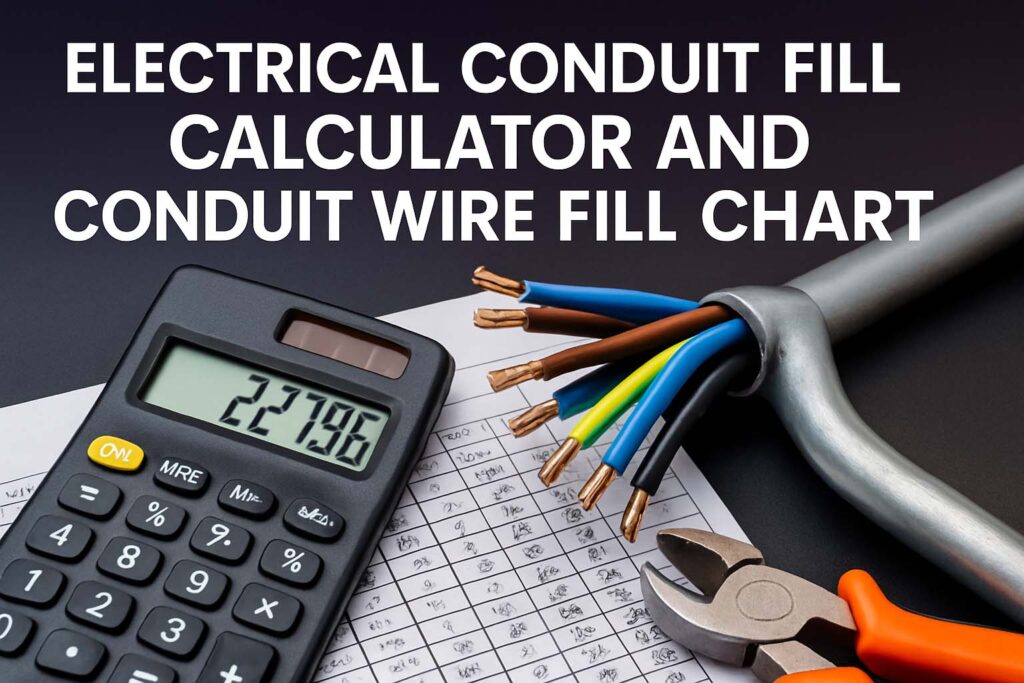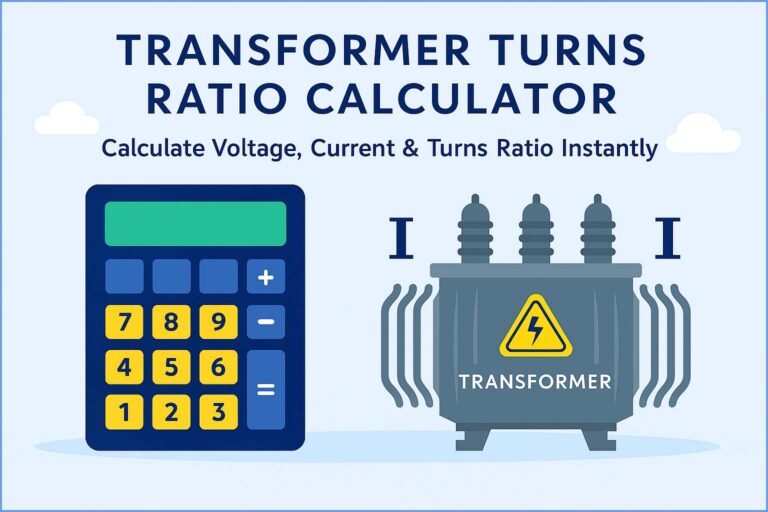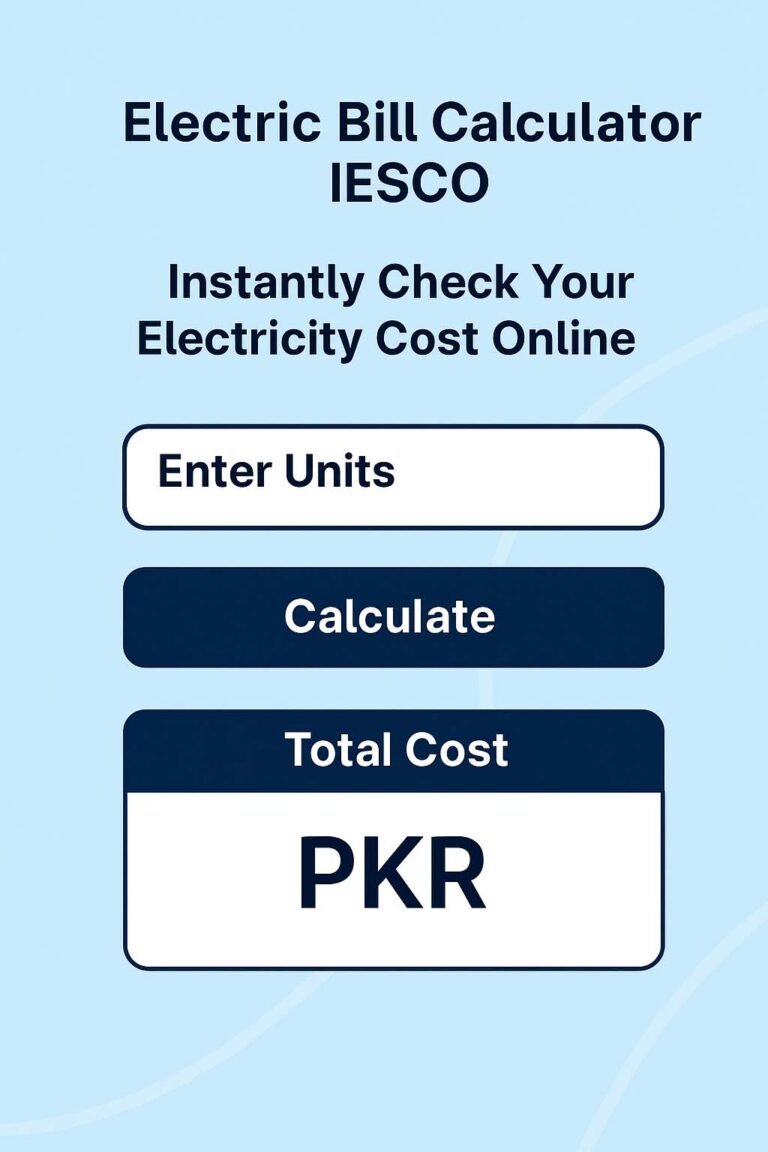Electrical Conduit Fill Calculator and Conduit Wire Fill Chart
When planning electrical installations, choosing the correct conduit size is critical for safety and efficiency. Overfilling a conduit can lead to overheating, signal interference, and even fire hazards. This is where an electrical conduit fill calculator becomes a valuable tool for electricians, contractors, and DIYers. It simplifies the process of determining how many wires can safely run through a specific conduit size, according to the NEC (National Electrical Code) guidelines.
Table of Contents
Table of Contents

Similarly, a conduit wire fill chart provides quick reference data to check conduit fill percentages based on wire sizes and types. While an electrical conduit fill calculator automates the math, a fill chart helps in on-site checks and estimations. Understanding both tools is essential for code-compliant and safe electrical design.
In this article, we’ll explore what these tools are, how they work, and why every professional should use them when planning wiring systems. We’ll also break down the technical principles behind conduit fill and include practical examples and charts to help you master the concept.
Use our online tool for free Conduit Fill Calculator (NEC Standard) – Understand Conduit Fill and Wire Capacity
Key Takeaways
- An electrical conduit fill calculator automates the process of finding how many wires can safely fit inside a conduit without violating NEC fill limits.
- A conduit wire fill chart offers ready-to-use reference data based on wire size, insulation type, and conduit dimensions.
- NEC allows 40% conduit fill for multiple wires, 53% for a single wire, and 31% for two wires in most standard applications.
- Using either the calculator or chart ensures compliance, avoids costly mistakes, and improves system reliability and safety.
Understanding the Electrical Conduit Fill Calculator
The electrical conduit fill calculator is designed to prevent overfilling conduits. It uses input like wire size (AWG), wire insulation type (THHN, XHHW, etc.), and conduit type (EMT, PVC, etc.) to calculate how many wires can be safely pulled through a particular size of conduit.
The primary function of the calculator is to apply NEC rules, especially those in Chapter 9, Table 1 and associated annexes. The NEC limits the amount of space that wires can occupy inside a conduit, not just to allow for physical pulling, but also to maintain heat dissipation and minimize electromagnetic interference.
For example, if you want to run 12 AWG THHN wires through a ¾ inch EMT conduit, the calculator determines how many you can run without exceeding the 40% fill limit for three or more conductors. This ensures your system operates safely and remains compliant with the code.
Use our online tool House Wiring Cable Size Calculator – Safe and Efficient Sizing for Home Circuits
Why Conduit Fill Matters
Filling a conduit beyond its permitted capacity can lead to major electrical issues. When wires are packed too tightly:
- Heat cannot escape properly, increasing the risk of insulation damage.
- Pulling wires becomes difficult, increasing the risk of tearing or nicking insulation.
- Future maintenance becomes nearly impossible without cutting conductors.
- Resistance and voltage drop can worsen due to compact conductor arrangements.
That’s why every designer, engineer, and electrician must know how to check fill capacity with a conduit wire fill chart or use an electrical conduit fill calculator when planning any installation.
Basic NEC Fill Rules to Know
Before diving deeper, let’s briefly cover NEC’s basic rules for conduit fill:
- 1 conductor in conduit: Max fill is 53% of internal area.
- 2 conductors: Max fill is 31%.
- 3 or more conductors: Max fill is 40%.
These percentages refer to the total cross-sectional area of the wires compared to the internal cross-sectional area of the conduit.
The internal area of conduits (in square inches) can be found in NEC Chapter 9, Table 4, while conductor dimensions are given in Table 5.
Use our online tool Short Circuit Current Calculator for Motors – Accurate Fault Current Calculation Guide
Conduit Wire Fill Chart for Common Sizes
Below is a simplified conduit wire fill chart based on THHN/THWN-2 copper wires in EMT conduit. It shows how many wires can be pulled without exceeding 40% fill:
| Conduit Size (EMT) | 14 AWG | 12 AWG | 10 AWG | 8 AWG | 6 AWG |
|---|---|---|---|---|---|
| 1/2 inch | 12 | 9 | 6 | 3 | 2 |
| 3/4 inch | 22 | 16 | 11 | 6 | 4 |
| 1 inch | 35 | 26 | 18 | 10 | 7 |
| 1-1/4 inch | 61 | 45 | 31 | 17 | 12 |
| 1-1/2 inch | 84 | 61 | 42 | 23 | 16 |
| 2 inch | 138 | 100 | 68 | 37 | 26 |
Note: Values are rounded and assume all wires have the same insulation type and are used in the same run.
This conduit wire fill chart is a handy tool for fast planning, but it doesn’t replace the accuracy of a calculator, especially when dealing with mixed wire sizes or insulation types.
How the Electrical Conduit Fill Calculator Works
An online electrical conduit fill calculator uses the following basic steps:
- Input the conductor size and quantity: Such as 10 AWG, 5 wires.
- Select the insulation type: THHN, XHHW, etc., as insulation affects wire diameter.
- Choose the conduit type and size: EMT, PVC, or flexible metallic conduit (FMC).
- Calculate: The tool computes total conductor area, compares it to allowed fill, and gives a result — either pass/fail or suggests the minimum required conduit size.
The calculator often includes NEC lookup tables internally, removing the need for manual reference.
Use our online tool Short Circuit Current Calculator for Transformers: Best Tool
Conduit Types and Their Impact on Fill
Different conduit materials have varying internal diameters, even if their trade size is the same. For example:
- EMT (Electrical Metallic Tubing) has a thinner wall, offering a larger internal area.
- PVC (Schedule 40/80) is thicker, meaning less usable area for the same nominal size.
- FMC (Flexible Metal Conduit) often has irregular shapes, reducing fill efficiency.
That’s why the same wire configuration may pass for EMT but fail in PVC or FMC. An accurate calculator will account for these differences.
Tips for Using the Conduit Fill Chart and Calculator Effectively
- Stick to one wire type per run whenever possible for easier calculation.
- Leave some room for future expansion – don’t push to the 40% limit unnecessarily.
- Use a larger conduit if running long distances to ease wire pulling.
- Be cautious of derating factors, especially if the number of conductors exceeds three, as ampacity adjustment is required.
- Always verify with NEC Tables for high-stakes or code-inspected projects.
Real-Life Example
Let’s say you need to run eight 12 AWG THHN copper wires for lighting circuits through EMT conduit. Using a conduit wire fill chart, you see that a ¾-inch EMT supports 16 wires of 12 AWG. Your fill is 50%, well below the limit, so it’s safe.
Now suppose you change the conduit to PVC Schedule 40. The internal area drops. Your calculator will likely recommend a 1-inch conduit to stay within 40%. This highlights how critical conduit type is in sizing decisions.
Use our online tool Short Circuit Current Calculator – Accurate Short Circuit Calculation for Safe Electrical Design
How to Calculate Conduit Fill Manually
To calculate fill without tools:
- Find the cross-sectional area of your wire (from NEC Table 5).
- Multiply by the number of wires.
- Find the internal area of conduit (from NEC Table 4).
- Divide total wire area by conduit area × 100 = % fill.
- Compare to the NEC limits (53%, 31%, or 40%).
While this is time-consuming, it teaches you how the fill is determined and improves design intuition.
Benefits of Conduit Fill Calculators and Charts
- Ensures NEC compliance with ease
- Reduces installation time by selecting correct conduit size upfront
- Minimizes error and rework, especially in large projects
- Improves cable management and safety
- Optimizes material use, saving costs in over- or under-sized conduits
Use our online tool Wire Size Calculator for Subpanels and Feeders – NEC Guidelines Included
Final Thoughts
Whether you’re planning a residential circuit or a complex industrial installation, the electrical conduit fill calculator and the conduit wire fill chart are essential tools. They help ensure your conduit runs are safe, compliant, and efficient. While charts are great for quick field use, calculators give precision for mixed conductor types and larger-scale projects.
Follow Us on Social:
Subscribe our Newsletter on Electrical Insights for latest updates from Electrical Engineering Hub
#ElectricalConduitFillCalculator, #ConduitWireFillChart, #NECConduitFill, #ConduitSizing, #WireFillCalculator, #ElectricalWiring, #ElectricalEngineering, #ConduitCapacity, #WireSizeCalculator, #ConduitInstallation, #NECStandards, #ElectricalDesign, #ElectriciansTools, #ElectricalSafety, #ConduitFillLimits
Electrical Conduit Fill Calculator and Conduit Wire Fill Chart : Electrical Engineering Hub

Use our Electrical Conduit Fill Calculator to quickly determine wire fill capacity, ensure NEC compliance, and choose the right conduit size for safe and efficient electrical wiring. Perfect for engineers, electricians, and DIY installers.
Price Currency: USD
Operating System: All
Application Category: UtilitiesApplication






